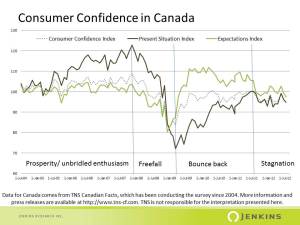There are no shortage of real world indicators of economic performance of an economy and its implications for everyday citizens but sometimes a public opinion measure offers us a clear alternative to hard economic stats.
Since 2004, consumer sentiment about the economy has moved through four distinct phases and we are now mired in a period of stagnation.
Let us consider these four phases:
- For much of the period between 2004 and the end of 2007, Canadians were in a period of perceived prosperity. It was unbridled if not irrational exuberance. With each passing year, people evaluated their personal situation as getting better and better. Expectations of the future did not adjust downward.
- Although it was the end of 2008 that witnessed the largest collapse in confidence, perceptions of the economy were largely in a free fall from 2008 to the middle of 2009.
- Between 2009 and the middle of 2011, there was a significant bounce back. While perceptions of the present did not return to July 2004 levels till the end of the period, expectations rose swiftly and remained positive.

- By July of 2011, stagnation was clearly setting in. Expectations for the future were not as positive as the previous period, and the growth in positive evaluations of the present was halted dramatically.
What this means?
The overall trend does make sense given a casual following of the economic news in Canada and the world over the past 8 years.
Until we see consistent and substantial movement in the indices, short-term changes are likely to be meaningless as most of those in the past year have been.
In the long-term, however, a lengthy period of stagnation means that public opinion has two ways to go — up or down. Which do you think will happen? When do you think we will break out of this period?
